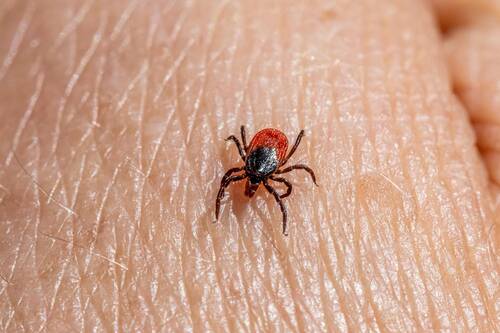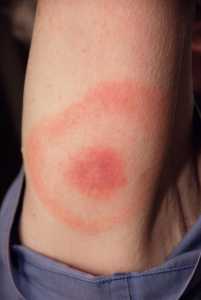Own a dog? Then your vet must have shared a thing or two about the risks of ticks and even warned you about Lyme disease.
But is your furry friend only at risk of this bacterial infection? You’re wrong if you think so. Humans can also get Lyme disease if a black-legged tick carrying the borrelia bacteria bites them.
Just recently, the comedian and actress Miranda Hart opened up about how she struggled with chronic fatigue syndrome after she was diagnosed with Lyme disease.
Many other famous people say they have been struck by this tick-borne bacterial infection. Those include Real Housewives of Beverly Hills star Yolanda Hadid and her daughter, model Bella Hadid, comic Amy Schumer, actor Ben Stiller, and singer Justin Bieber.
As high-profile names share their struggles, awareness of Lyme is spreading fast. But so are the myths. So, let’s separate the facts from the fiction surrounding this disease.
Author Interviews, Lyme / 13.03.2020
New Lyme Disease Model Could Help Track Spread of Tick Disease to Midwest and South
MedicalResearch.com Interview with:
Donal Bisanzio PhD DVM
Senior Epidemiologist
RTI International
MedicalResearch.com: What is the background for this study?
Response: The number of reported cases of Lyme disease has steadily increased since the year 2000. The Centers for Disease Control Prevention (CDC) estimates that nearly 30,000 cases are reported each year with close to 270,000 unreported cases. The high fraction of unreported cases is linked with the absence of specific disease symptoms, which can deter physicians from an initial diagnosis. Another critical factor causing underreporting is the low accuracy of methods used to test Lyme disease. These factors show us that some counties that are currently considered Lyme disease-free may only have this status due to underreporting.
RTI International, in collaboration with Columbia University, built a model to show factors affecting the diffusion of case reporting in the north-eastern U.S. from 2000 to 2017 and identify which counties may be experiencing underreporting. The model used publicly available data published each year by the CDC on cases reported at the county-level merged with information on vector distribution and data obtained by satellite surveys. The model included 855 counties located in 31 states in the West North Central, East North Central, New England, Mid-Atlantic, and Southern regions of the U.S. The final product was a map showing the probability of counties of the north-eastern U.S. to report Lyme disease cases. (more…)
Author Interviews, CDC, Lyme / 23.06.2017
Unorthodox Treatment of Presumed Chronic Lyme Disease Can Be Deadly
MedicalResearch.com Interview with:
Dr. Christina Nelson, MD MPH
Medical epidemiologist, Division of Vector-Borne Diseases
CDC
MedicalResearch.com: What is the background for this study?
Response: Patients who are given a diagnosis of “chronic Lyme disease” have been offered a variety of treatments that have not been shown to be effective. Many patients are treated with prolonged courses of antibiotics (for months or years), which have not been shown to provide substantial long-term benefit to patients. Anecdotal reports about adverse outcomes associated with these treatments for chronic Lyme disease are common, but there have not been systematic efforts to collect data about the frequency of these events.
MedicalResearch.com: Why is the diagnosis of 'Chronic Lyme Disease' so common?
Response: The term “chronic Lyme disease” (CLD) has been used to describe people with different illnesses. While the term is sometimes used to describe illness in patients with Lyme disease, in many occasions it has been used to describe symptoms in people who have no evidence of a current or past infection with Lyme disease. Because of the confusion in how the term CLD is employed, experts in this field do not support its use.
(more…)
Author Interviews, CDC, Lyme, Race/Ethnic Diversity / 08.03.2016
Lyme Disease Detected At Later Stage in Hispanics
MedicalResearch.com Interview with:
Christina Nelson, MD, MPH, FAAP
Medical Epidemiologist
Centers for Disease Control and Prevention
Division of Vector-Borne Diseases | Bacterial Diseases Branch
Fort Collins, CO
MedicalResearch.com: What is the background for this study? What are the main findings?
Dr. Nelson: Since Lyme disease is a nationally notifiable disease, state and local health departments collect reports of Lyme disease cases in their jurisdictions then share this data with CDC. This surveillance data is very informative and can be used to track disease patterns.
Hispanics comprise roughly 45% of the U.S. workforce in outdoor jobs such as grounds maintenance, farming, fishing, and forestry, so they potentially have an increased risk of Lyme disease. Since information on Lyme disease in Hispanics is very limited, we decided to look into this topic further by analyzing surveillance data.
(more…)
More on Lyme Disease on MedicalResearch.com
MedicalResearch.com Interview with:
Rebecca Eisen PhD research biologist and
Ben Beard, Ph.D.
Chief, Bacterial Diseases Branch
Division of Vector-Borne Diseases
Centers for Disease Control and Prevention
Medical Research: What is the background for this study?
Dr. Eisen: Since the late 1990s, the number of reported cases of Lyme disease in the United States has tripled and the number of counties in the northeastern United States that are considered high-risk for Lyme disease has increased by more than >320%.
In 1998, a comprehensive review was published that described the geographic distributions of the blacklegged tick (Ixodes scapularis) and the Western blacklegged tick (Ixodes pacificus). These ticks are responsible for infecting humans with the pathogens that cause Lyme disease, anaplasmosis, and babesiosis.
Medical Research: Would you tell us about the methodology?
Response: CDC researchers recently published an update to the 1998 tick distribution map. The authors reviewed the scientific literature and individual state health department websites for data. Additionally, they contacted public health officials, entomologists, and Lyme disease investigators throughout the United States to assess county-level tick collection data.
Researchers characterized counties with Ixodes scapularis and Ixodes pacificus ticks as “established” if at least 6 individual ticks or at least 2 of the 3 tick life stages had been identified during a collection period. Counties were characterized as “reported” if at least one tick of any life stage had been identified at any time in that county, or if county records did not specify the number of ticks or life stages collected.
(more…)
Author Interviews, Biomarkers, Lyme, Rheumatology / 10.11.2015
microRNAs in Joint Fluid As Biomarker For Antibiotic Refractory Lyme Arthritis
MedicalResearch.com Interview with:
Robert B. Lochhead PhD
Clinical Fellow in Medicine
Division of Rheumatology, Allergy & Immunology
Massachusetts General Hospital
Harvard Medical School, Boston, MA
Medical Research: What is the background for this study? What are the main findings?
Dr. Lochhead: Lyme arthritis (LA), caused by the tick-borne spirochete Borrelia burgdorferi, usually resolves appropriately with antibiotic treatment, called antibiotic-responsive Lyme arthritis. However, in some patients, arthritis persists for months or years after spirochetal killing with oral and IV antibiotic therapy, called antibiotic-refractory Lyme arthritis. Synovial lesions in these patients show marked synovial proliferation, inflammation, and vascularization, accompanied by autoimmune T and B cell responses. MicroRNAs (miRNAs) regulate many biological processes including inflammation, immune responses, and cell proliferation, and are effective biomarkers that may reveal molecular mechanisms of disease. Our objective here was to identify extracellular miRNAs (ex-miRNAs) in synovial fluid (SF) that distinguish regulated (responsive) from dysregulated (refractory) immune responses in Lyme arthritis, thereby providing insights into underlying biological processes and potential diagnostic biomarkers to distinguish between these disease courses.
(more…)
Author Interviews, Infections, Lyme, NEJM / 02.07.2013
New Tick-Borne Borrelia Disease: Two more cases discussed
MedicalResearch.com Interview with:
Sam R. Telford III, ScD
Department of Infectious Disease and Global Health,
Tufts University, Cummings School of Veterinary Medicine,
200 Westboro Road, North Grafton, MA
Borrelia miyamotoi Infection Presenting as Human Granulocytic Anaplasmosis: A Case Report
MedicalResearch.com: What are the main findings of the study?
Answer: The study presents two additional cases of BMD (Borrelia miyamotoi disease) that add to our knowledge of the spectrum of illness of this recently recognized zoonosis. Our report of the North American index case in NEJM in January 2013 described a case-patient who was elderly and immunocompromised and it was not clear whether that case was just very unusual. With our Annals report, we describe cases in immune-intact individuals and suggest that cases of BMD may have been under our noses all along, just presumptively diagnosed as HGA and successfully treated with doxycycline with no followup (e.g., lab confirmation of diagnosis of HGA Human Granulocytic Anaplasmosis). Hence, individuals presenting with fever, headache, myalgia, and show leukopenia and elevated LFTs may have either HGA or BMD and confirmatory testing should be done accordingly. It should be noted that all tick borne diseases are clinical diagnoses and treatment of an acute case should not depend on "lab tests". Both these infections are effectively managed by oral doxycycline, hence those with these signs and symptoms might be empirically treated with doxycyline, which would be important in areas where RMSF and tularemia (which also produce leukopenia and elevated LFTs) co-occur with deer tick -transmitted infections such as Lyme disease; waiting for "lab tests" to confirm RMSF or tularemia might lead to a negative outcome. RMSF and tularemia are the most dangerous of the tick American tick borne diseases, although I would certainly place the very rare deer tick virus and Powassan virus in the same category.
(more…)
Author Interviews, Infections, Lyme / 27.06.2013
Lyme Borrelia: Different Antibody Responses in Late-stage infection with American vs European strains
MedicalResearch.com Interview with: Xin Li, Ph.D.
Assistant Professor
Department of Veterinary Biosciences
The Ohio State University
344 Veterinary Medicine Academic Building
Columbus, OH 43210
MedicalResearch.com: What are the main findings of the study?
Dr. Xin Li : Antibody responses to borrelial antigens that are primarily expressed during the tick phase the spirochetes’ life cycle are common in American patients with Lyme arthritis, a late-stage manifestation of Lyme borreliosis, but are rare in American patients with early-stage infection or European patients with early- or late-stage infection.
(more…)


